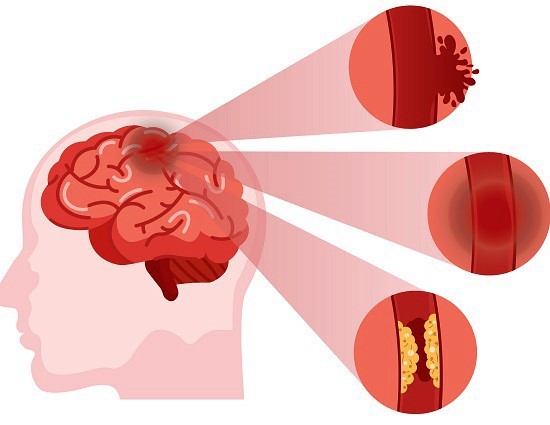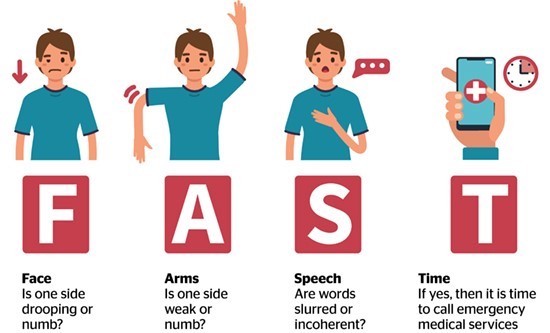Around the world,
May is known as stroke awareness month. A stroke is one of the most serious
cardiovascular events that can occur and frequently results in death or
disability.
اضافة اعلان
Globally, strokes are also one of the most common
causes of death and Jordan is no exception.
According to the
Center for Disease Control and
Prevention, strokes are the third leading cause of death in Jordan (12
percent).
Due to the relatively high prevalence of this
life-threatening event, understanding the signs and symptoms can ensure rapid
and adequate response which can potentially save a life and avoid disability.
What is a stroke?
Our brain is one of, if not the most, demanding organ in the
body. Its constant functioning results in a continuous demand for components essential
to life, primarily oxygen.
In order to deliver oxygen, as well as other components, to
the brain, the body uses the cardiovascular system. If, for whatever reason,
there is a drastic reduction or complete stop in blood flow to the brain, the
cells of the brain become damaged and begin to die within minutes.
In short, the essence of a stroke is inadequate
oxygen being
delivered to the brain which results in cell death.
Types of strokes
In general, there are two ways a stroke occurs, either due
to an obstruction or a rupture. As a result, three primary types of strokes can
occur, although two have a great deal of overlap.
These include a transient ischemic attack (TIA),
ischemic stroke, and hemorrhagic stroke. A TIA and an ischemic stroke involve
obstruction of a blood vessel that delivers blood to the brain, whereas a hemorrhagic
stroke involves a rupture in the blood vessel causing blood flow to be
dramatically reduced.
How do strokes happen?
An obstruction and rupture are the results of two different processes.
In a hemorrhagic stroke (rupture), an artery will either rupture or leak blood
into the surrounding area. Along with the lack of oxygen being delivered to the
brain, the release of blood into the area creates an increase in pressure on
the brain which can further damage the surrounding tissue.
Generally speaking, a hemorrhagic stroke is the result of conditions
related to the weakening of blood vessels themselves, or a result of trauma.
Two common conditions that cause the weakening of blood
vessels are aneurysms and arteriovenous malformations (AVMs). An aneurysm is a weakening
of the blood vessel wall that results in a bulging or ballooning and has the
potential to burst. There are many causes of aneurysms, but they are typically
developed later in life.
An AVM, on the other hand, is a condition that an individual
is born with. It is the result of tangled blood vessels where arteries and
veins bypass one another.
Hemorrhagic strokes can also be the result of trauma or
damage to the head that results in internal bleeding. Furthermore, hemorrhagic
can be divided into two subtypes that characterize where the bleeding occurs.
An intracerebral hemorrhage is bleeding that occurs within
the brain, whereas a subarachnoid hemorrhage occurs in the space surrounding
the brain. Intracerebral hemorrhages are nearly twice as common as subarachnoid
hemorrhages and all hemorrhagic strokes account for 13 percent of all stroke
cases according to the American Heart Association (AHA).
In the case of obstruction, the blockage can resolve on its
own or be more permanent. When it resolves on its own, it is known as TIA or a
“mini-stroke.” In TIA the obstruction is only temporary and disappears after a
few minutes or hours.

Although not a true stroke, a TIA still mimics many signs
and symptoms of a full stroke and is predictive of a future full stroke. According
to the CDC, over a third of those who experience of TIA and go without
treatment have a major stroke within a year and up to 10–15 percent will have a
major stroke within three months.
When the obstruction does not resolve on its own, it is
known as an ischemic stroke. The most common cause of an ischemic stroke is due
to a condition known as atherosclerosis.
Atherosclerosis is fatty deposits that line vessel walls
which can lead to the formation of blood clots. The two types of obstruction refer
to where the clot originated from and are known as cerebral thrombosis (thrombotic
stroke) and cerebral embolism (
embolic stroke).
Cerebral thrombosis is when the clot is formed at the fatty
deposit in the blood vessel and a cerebral embolism is when a clot is formed in
another area of the body and then breaks off to later be lodged in the arteries
of the brain. According to the AHA, ischemic strokes account for 87 percent of
all stroke cases.
Signs and symptoms of a stroke and how to help
In those who are suffering from a stroke, time is of the
essence. Due to the lack of oxygen being delivered to the
brain, tissue damage,
and death can occur within minutes.
The longer the individual goes without treatment, the
greater the area of damage to the brain is. This can ultimately result in permanent
brain damage, long-term disability, and, in unfortunate cases, death.
A stroke can present in many ways and cause a variety of
symptoms but there are three signs that are most important. These signs are
easily remembered by the acronym FAST, which stands for face, arms, speech, and
time.

This acronym can be used to self-assess the signs of a stroke
but is most ideally used to help recognize a stroke in another person. The
letter F (face) refers to the numbness or drooping of the face that is
experienced during a stroke.
The drooping of the face appears on one side and becomes
more evident when asked to smile. The letter A (arms) refers to the effect that
stroke has on the limbs. Typically, this presents as one-sided numbness or
weakness that occurs in the arms. The easiest way to assess this is by asking
the individual to raise both arms out in front of them. If they are unable to raise
one arm, then this is a sign of stroke.
The letter S (speech) refers to slurred or incoherent speech
that can commonly occur during a stroke. If an individual presents with any of
these signs, then it is time to call emergency
medical services, hence the
letter T in FAST.
It is also important to note the time in which these
symptoms presented. In the case of ischemic stroke, most agents need to be
administered within four hours from the onset of symptoms in order to
potentially reverse or stop symptoms from developing.
If you are tending to an individual suffering from a stroke,
do not provide them with any water, food, or medication. Due to the weakness
that occurs during a stroke, swallowing can be difficult which may pose a
choking hazard.
Although 87 percent of strokes are ischemic and could benefit
from the use of blood thinners such as aspirin, it is impossible to know if it is
actually a hemorrhagic stroke upon initial evaluation. If you give aspirin to
an individual experiencing a
hemorrhagic stroke, you can cause more harm.
The best course of action is to keep the individual under
close observation until an ambulance arrives and do not attempt to drive the
individual yourself so the first responders can provide assessment while en
route.
Read more Health
Jordan News



